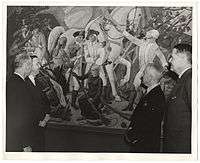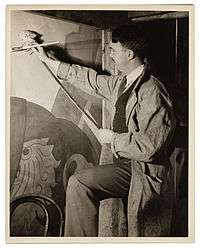Tom Loftin Johnson (artist)
| Tom Loftin Johnson | |
|---|---|
|
Tom Loftin Johnson in 1938 | |
| Born |
1905 Denver, Colorado United States |
| Died | unknown |
| Nationality | American |
| Education |
École des Beaux-Arts Yale School of Art |
| Occupation | Artist, Educator |
| Employer | West Point |
| Known for |
Panorama of Military History at West Point American Pieta at the Carnegie Museum of Art Murals at Fort Niagara State Park |
| Title | Major |
Major Tom Loftin Johnson (born 1905; death date unknown) was an American painter and an art teacher at West Point. He created public murals – the largest of which was 70 feet (21 m) long. His American Pietà painting, which won $1,000 in the 1941 Carnegie International contest, was intended to highlight the race problem in the United States. A Pietà is meant to show the Virgin Mary holding the crucified Jesus. In Johnson's American Pietà, the black mother holds her lynched son whilst others hide his tortured body.
Biography
Tom Loftin Johnson was born in Denver, Colorado in 1905. He was trained at the Yale School of Art, where he illustrated campus humor magazine The Yale Record.[1] After Yale, he trained at the École des Beaux-Arts in Paris.[2]
It is said that Johnson requested that his remains be placed with a plaque on the West Point mural with the inscription: "He gave his best to West Point". To date, this has not been done, even when the mural was restored in 2006.[3]
Works

Johnson is known for the government-funded murals he created during the Depression. Panorama of Military History, at the United States Military Academy in West Point, New York, is probably his best-known work,[2] covering the south wall, with Edward Shepherd Creasy's Fifteen Decisive Battles of the World.[4] This is the largest American mural using egg tempera. The 70-foot-long (21 m) mural required the yolks of 35 dozen fresh eggs mixed with oil to make the paint.[5] Johnson was paid $30 a week and his assistant $20. Johnson chose the 20 globally most important battles including those that featured Napoleon, Joan of Arc, and Hannibal.[6]
Johnson also painted five murals at The Officer's Club at Fort Niagara State Park, which commemorate the history of the 28th regiment from its founding in 1905.[2]

Johnson won $1,000 in the Carnegie International Art contest of 1941. Because the Second World War was in full progress, the committee had been obliged to accept only the 5,000 American entries. Although some considered that the entries were poor, it was Johnson who was chosen as the winner. He had entered a painting called American Pietà, which instead of showing the Virgin Mary cradling the crucified Jesus, showed an African American family group after it had just been given back the body of a lynched man.[7] The painting was unapologetically anti-racist and documented the pain of the people involved, showing the grief and giving indications of the sadistic castrations that usually accompanied racial lynchings.[7]
References
| Wikimedia Commons has media related to Tom Loftin Johnson. |
- ↑ Johnson, Tom Loftin (May, 1920). Cover Illustration. The Yale Record. New Haven: Yale Record.
- 1 2 3 The Officers Club, at Fort Niagara State Park, accessed December 2011
- ↑ "Class of 76 reunion". West Point. Retrieved 21 December 2011.
- ↑ Waugh, Elizabeth (1944). West Point. Macmillan.
- ↑ "Art: World's Arms". Time magazine. 20 July 1936. Retrieved 29 December 2011.
- ↑ Isenhour, Jack (2003). Same Knight, Different Channel: Basketball legend Bob Knight at West Point and today. ISBN 978-1-57488-634-4.
- 1 2 3 Tapla, Ruby C, (2011). American Pietas: Visions of Race, Death, and the Maternal p.10. p. 240. ISBN 978-0-8166-5311-9.
